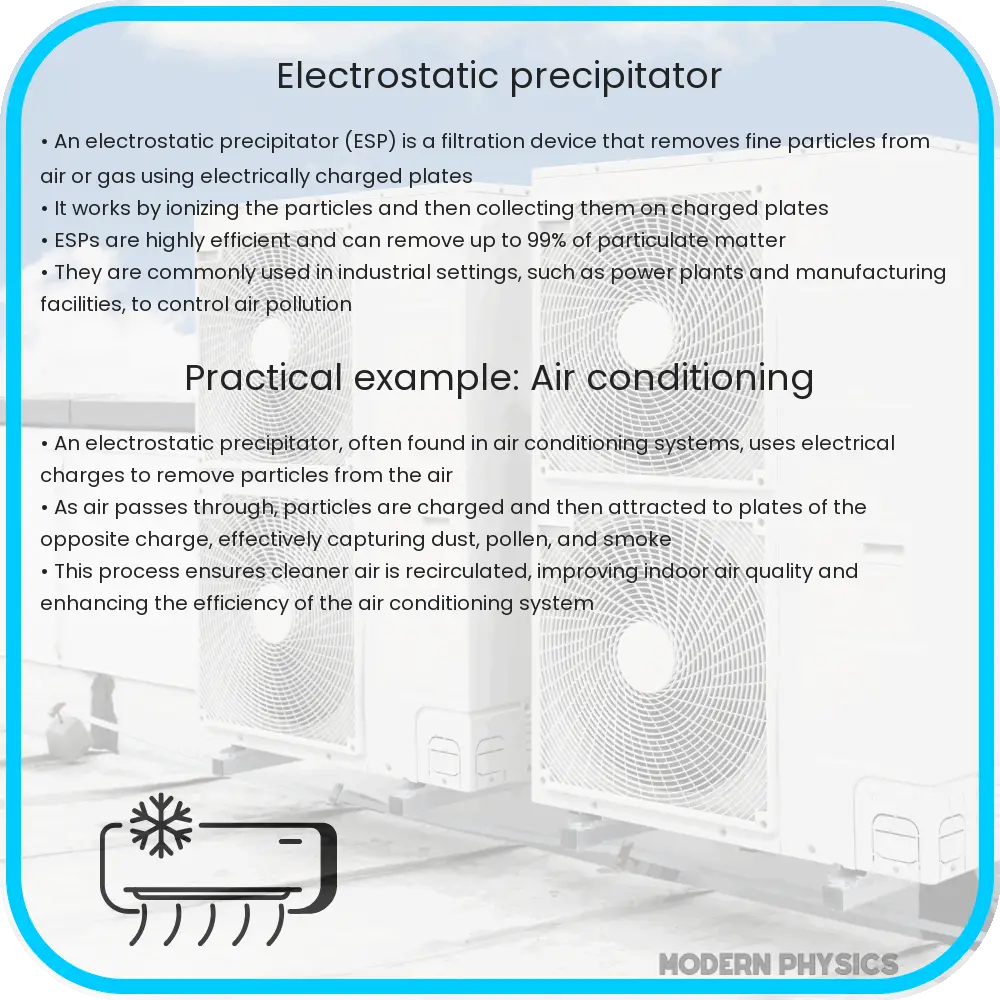Explore electrostatic precipitators’ efficiency, maintenance, costs, and advanced techniques for optimal industrial air pollution control.

Understanding Electrostatic Precipitators: An Overview
Electrostatic precipitators (ESPs) are a crucial component in the realm of industrial air pollution control. Widely used to remove fine particulate matter from exhaust gas streams, ESPs operate by charging particles in a gas stream and then collecting them on charged plates. This technology plays a pivotal role in maintaining air quality standards in various industries, including power plants, metal processing, cement manufacturing, and more.
Efficiency of Electrostatic Precipitators
The efficiency of an ESP is primarily determined by three factors: the electrical properties of the particles, the design of the ESP, and the gas velocity through the collector. Theoretically, ESPs can achieve more than 99% particle removal efficiency. However, actual efficiency depends on the specific conditions of operation, including particle size distribution, gas composition, and temperature. The performance of an ESP is often represented by the Deutsch-Anderson equation:
η = 1 – e-(A·Q1)/(V·Q)
where η is the collection efficiency, A is the total collection area, V is the gas flow rate, and Q1 and Q are constants based on particle charge and mobility.
Maintenance of Electrostatic Precipitators
Maintenance plays a crucial role in the performance and longevity of an ESP. Routine checks include inspecting and cleaning discharge and collection electrodes, ensuring proper electrical operation, and checking for air leakages. Electrode alignment and spacing are critical for efficient particle charging and collection. Additionally, hopper evacuation systems must be maintained to prevent particle re-entrainment into the gas stream.
Cost Considerations
The initial cost of installing an ESP can be substantial, but this must be weighed against long-term operational savings and environmental compliance. Factors influencing the cost include the size of the ESP, the specific requirements of the gas stream (such as temperature and composition), and the required efficiency. Operational costs include power consumption, maintenance, and periodic replacement of components like electrodes and insulators.
ESPs also offer cost advantages in terms of regulatory compliance. As governments worldwide tighten environmental regulations, investing in efficient pollution control technologies like ESPs becomes not just an operational necessity but also a strategic decision. Furthermore, advancements in ESP technology, such as improved electrode materials and designs, are continually reducing operational costs and enhancing efficiency.
Understanding the balance between efficiency, maintenance, and cost is key to optimizing the use of electrostatic precipitators in industrial settings. In the next section, we will delve deeper into advanced techniques for improving ESP performance and explore the future of this vital technology in pollution control.
Advanced Techniques for Enhancing ESP Performance
To further improve the performance of electrostatic precipitators, several advanced techniques can be employed. One such technique is the use of pulse energization in place of traditional constant voltage. Pulse energization involves applying high voltage pulses to precipitator electrodes, which can lead to more effective particle charging and reduced power consumption. Additionally, computerized control systems are increasingly being used to optimize ESP operations, adjusting parameters like voltage and gas flow in real-time based on data analytics.
Adapting ESPs for Diverse Industrial Requirements
ESPs need to be adapted to the specific requirements of different industries. For instance, in industries dealing with high-temperature gases, like steel manufacturing, the ESPs are designed to withstand extreme temperatures. Similarly, in industries where the particulate matter is highly resistive, such as in cement manufacturing, specialized ESP designs, like moving electrode type ESPs, are used to enhance particle removal efficiency.
The Future of Electrostatic Precipitators
The future of ESP technology is geared towards integration with other air pollution control systems for a more holistic approach to environmental management. Innovations in materials science, such as the development of corrosion-resistant and high-temperature tolerant materials, are expanding the applicability of ESPs in various industrial scenarios. Moreover, advancements in IoT and AI are paving the way for smart ESPs that can predict maintenance requirements, optimize performance, and reduce downtime.
Conclusion
Electrostatic precipitators remain a cornerstone in industrial air pollution control strategies. Their ability to efficiently remove fine particulate matter from exhaust gases makes them indispensable in many industries. The balance between efficiency, maintenance, and cost is crucial for their optimal operation. With ongoing advancements in technology and a shift towards integrated pollution control solutions, ESPs continue to evolve, offering more sustainable and cost-effective options for industries committed to environmental stewardship. As regulations around air quality grow stricter, the role of ESPs in meeting these standards becomes increasingly significant, making them a vital tool in the global effort to reduce industrial air pollution.
